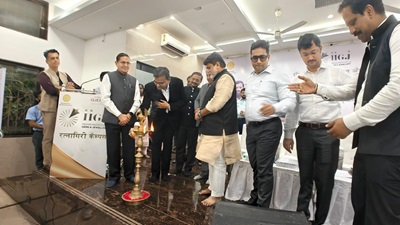The Gem & Jewellery Export Promotion Council (GJEPC) marked a significant milestone on 24th September 2024, with the inauguration of the Indian Institute of Gems & Jewellery (IIGJ) training and skilling centre in Ratnagiri, Maharashtra

Shri Uday Samant, Hon’ble Minister of Industries, Government of Maharashtra, officially inaugurated the Indian Institute of Gems & Jewellery (IIGJ) training and skilling centre in Ratnagiri. The launch is a significant milestone in the Gem & Jewellery Export Promotion Council’s (GJEPC) ongoing efforts to expand educational and vocational opportunities in the jewellery sector.
The event was attended by notable figures including Shri Kirit Bhansali, Vice Chairman of GJEPC; Shri M. Devender Singh, District Collector, Ratnagiri; Shri Kirthi Kiran Pujar, CEO of Zilla Parishad, Ratnagiri; Shri Sabyasachi Ray, Executive Director of GJEPC; and Shri Debasish Biswas, CEO of IIGJ.
Empowering the Next Generation
During the inauguration, Shri Uday Samant expressed his appreciation for the initiative, stating, "The gem and jewellery industry is a key driver of economic growth. This training centre in Ratnagiri will provide youth from the region with valuable skills, allowing them to contribute meaningfully to India’s gem and jewellery industry." He added that while the institute is starting small, it has the potential to evolve into a major educational hub in the future.
Shaping the Future of the Industry
Kirit Bhansali, Vice Chairman of GJEPC, emphasized the importance of skilling for the sector's growth: “The future of the gem and jewellery industry will heavily rely on skilled professionals. Centres like IIGJ Ratnagiri will equip the next generation with the expertise necessary to meet the growing demands of the industry, ensuring that India remains a global leader in this field.”
He highlighted Maharashtra’s pivotal role in the industry, contributing 70% of India’s gem and jewellery exports, valued at USD 32 billion in FY 2023-24. He also mentioned the impact of international agreements like the India-UAE CEPA, which are expected to further boost the sector.
Commitment to Skill Development
The Ratnagiri centre will train 350 students annually in various aspects of jewellery design and manufacturing, offering specialized courses such as metal setting, CAD (computer-aided design), and polishing. This state-of-the-art facility is part of a broader network of IIGJ institutes in Mumbai, Jaipur, and Delhi, all aimed at providing modern, industry-relevant training.
In line with the Skill India mission set by Hon'ble Prime Minister Shri Narendra Modi, GJEPC is committed to training 20 lakh youth over the next five years. Centres like IIGJ Ratnagiri will contribute to achieving the ambitious target of USD 75 billion in jewellery exports by 2030.
Supporting Traditional Jewellery Clusters
The GJEPC is also focused on preserving traditional jewellery-making techniques. Shri Bhansali mentioned ongoing efforts to support Maharashtra’s traditional jewellery clusters, including the Hupari Cluster in Kolhapur, known for its Geographical Indication (GI) certified silver jewellery. The GJEPC is assisting in establishing a Common Facility Centre (CFC) to help local artisans scale their operations.
With initiatives like the India Jewellery Park in Mumbai and multiple skilling centres, GJEPC aims to generate over 2 lakh jobs in Maharashtra alone, empowering local talent and securing the future of the jewellery industry in India.
Be the first to comment